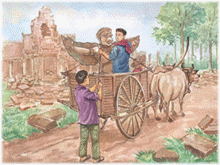 An independently-made eighty-minute feature film called Last Seen At Angkor is showing at the Action on Film festival in Los Angeles today, having been shot on a shoestring budget, using mostly local actors, in Cambodia, Thailand and Laos. Written and directed by Michael R Morris, who also takes the lead role alongside Wee Hong Thomas Lim, its a story of a man who has been searching for his missing fiance and returns to Cambodia one last time in hopes of finding her. Against a backdrop of the beauty of Southeast Asia, his search takes him outside the law and into the grip of a human trafficking nightmare. You can see a short trailer of the film at angkormovie.com. Read a note from Michael R Morris in the comments section.
An independently-made eighty-minute feature film called Last Seen At Angkor is showing at the Action on Film festival in Los Angeles today, having been shot on a shoestring budget, using mostly local actors, in Cambodia, Thailand and Laos. Written and directed by Michael R Morris, who also takes the lead role alongside Wee Hong Thomas Lim, its a story of a man who has been searching for his missing fiance and returns to Cambodia one last time in hopes of finding her. Against a backdrop of the beauty of Southeast Asia, his search takes him outside the law and into the grip of a human trafficking nightmare. You can see a short trailer of the film at angkormovie.com. Read a note from Michael R Morris in the comments section.
Sunday, July 30, 2006
Last Seen At Angkor
Khmer Rouge culpability
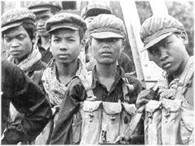 The forthcoming Tribunal to put on trial the senior leaders of Democratic Kampuchea who planned or gave orders, as well as those most responsible for committing serious crimes, should at least include surviving members of the DK's Central Committee and the senior officials and military commanders of the six Zones, into which the country was divided. Low level and middle-ranking Khmer Rouge cadre - at regional, district, sub-district and village level - are however unlikely to face prosecution, whilst the court's powers to indict will be limited to crimes committed in Cambodia between 17 April 1975 and 6 January 1979. The process to collect evidence and decide whom to charge and with what crimes has already begun. Experts like Stephen Heder, a leading scholar on Cambodia, is one of the prosecution's investigators. Overwhelming evidence of horrendous crimes has been amassed over the past two decades but the challenge for the prosecution will be to marshal enough evidence to prove individual guilt for particular crimes.
The forthcoming Tribunal to put on trial the senior leaders of Democratic Kampuchea who planned or gave orders, as well as those most responsible for committing serious crimes, should at least include surviving members of the DK's Central Committee and the senior officials and military commanders of the six Zones, into which the country was divided. Low level and middle-ranking Khmer Rouge cadre - at regional, district, sub-district and village level - are however unlikely to face prosecution, whilst the court's powers to indict will be limited to crimes committed in Cambodia between 17 April 1975 and 6 January 1979. The process to collect evidence and decide whom to charge and with what crimes has already begun. Experts like Stephen Heder, a leading scholar on Cambodia, is one of the prosecution's investigators. Overwhelming evidence of horrendous crimes has been amassed over the past two decades but the challenge for the prosecution will be to marshal enough evidence to prove individual guilt for particular crimes.
Crimes committed after 1979 will not come under scrutiny. Which means that the perpetrators of the murder of British de-miner Christopher Howes, will not face trial unless brought to book by the existing Cambodian legal system. Howes, and his Khmer interpreter Houn Hourth, were captured and killed by the Khmer Rouge in March 1996. Eyewitness testimony suggests that the order to murder Howes came from the recently deceased warlord Ta Mok but was allegedly carried out by men under his command near the northern Khmer Rouge stronghold of Anlong Veng. To-date, no-one has been charged with the Howes murder.
Part of My Soul - Loung Ung
 I've just finished watching the excellent NECN documentary, Part of My Soul: The Odyssey of a Child of Genocide, an award-winning account of author Loung Ung's life in Cambodia and America. It features her sister Chou, who Loung had to leave behind when she emigrated to the States, and their stories, growing up in very different environments, are the backbone of her poignant second book, Lucky Child. Loung very kindly sent me a copy of the documentary, together with a second hour-long documentary, by NHK, in both Japanese and English, which was filmed in 2000, at the time of the release of her first book, First They Killed My Father. Both of Loung's books have been re-published this year by Harper Perennial and can be obtained here.
I've just finished watching the excellent NECN documentary, Part of My Soul: The Odyssey of a Child of Genocide, an award-winning account of author Loung Ung's life in Cambodia and America. It features her sister Chou, who Loung had to leave behind when she emigrated to the States, and their stories, growing up in very different environments, are the backbone of her poignant second book, Lucky Child. Loung very kindly sent me a copy of the documentary, together with a second hour-long documentary, by NHK, in both Japanese and English, which was filmed in 2000, at the time of the release of her first book, First They Killed My Father. Both of Loung's books have been re-published this year by Harper Perennial and can be obtained here.
The photo above shows Loung and her older sister Chou (in white), reunited in Cambodia. The NHK (Japan's National Public Broadcaster) documentary was called First They Killed My Father. An interview with the producer/director of the NHK program, Kayoko Mitsumatsu, can be viewed here. The photo of Loung below, taken by Gigi Cohen, appeared in the Sunday Times magazine in April 2000.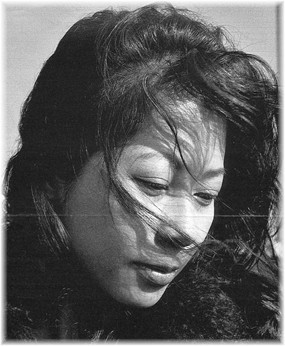
Saturday, July 29, 2006
The Haing Ngor Foundation
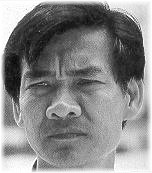 2006 marks the tenth anniversary of the death of Haing S Ngor, surgeon, survivor, actor, humanitarian and activist, who died on 25 Februuary 1996. The Chicago Tribune said of Haing S Ngor; "He starred in the best film on Cambodia that has ever been produced. And now he has written the best book on Cambodia that has ever been published." And I have to agree with that view entirely. The film in which he starred and won an Oscar, The Killing Fields, was a watershed in bringing the true fate of the Khmer people to worldwide audiences that no tv news-slot or documentary ever could. And his book, which he co-wrote with Roger Warner, A Cambodian Odyssey, was an incredibly moving account of his life and survival under the Khmer Rouge regime. His murder, at the hands of a street gang, robbed us all of a very special Cambodian.
2006 marks the tenth anniversary of the death of Haing S Ngor, surgeon, survivor, actor, humanitarian and activist, who died on 25 Februuary 1996. The Chicago Tribune said of Haing S Ngor; "He starred in the best film on Cambodia that has ever been produced. And now he has written the best book on Cambodia that has ever been published." And I have to agree with that view entirely. The film in which he starred and won an Oscar, The Killing Fields, was a watershed in bringing the true fate of the Khmer people to worldwide audiences that no tv news-slot or documentary ever could. And his book, which he co-wrote with Roger Warner, A Cambodian Odyssey, was an incredibly moving account of his life and survival under the Khmer Rouge regime. His murder, at the hands of a street gang, robbed us all of a very special Cambodian.
You can read all about Haing S Ngor at the website of the Foundation set up in his name, haingngorfoundation.org.
Visit my Killing Fields webpage for more on the film of the same name.
Friday, July 28, 2006
Theary Seng : KR Tribunal Watch
 Theary Seng, author of the Khmer Rouge survivor memoir, Daughter of the Killing Fields : Asrei's Story, now living back in Cambodia as a US-qualified lawyer and executive director of the Center for Social Development in Phnom Penh, and a keen advocate for the pending tribunal to bring to account the surving members of the Khmer Rouge hierachy, has posted her new website at thearyseng.com.
Theary Seng, author of the Khmer Rouge survivor memoir, Daughter of the Killing Fields : Asrei's Story, now living back in Cambodia as a US-qualified lawyer and executive director of the Center for Social Development in Phnom Penh, and a keen advocate for the pending tribunal to bring to account the surving members of the Khmer Rouge hierachy, has posted her new website at thearyseng.com.
A 25-minute video interview with Ms Seng (pictured) can be seen on the BBC's HARDtalk news programme website here, where she describes her life under the KR and the heart-wrenching loss of both of her parents.
Tang Kim's evidence
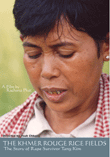 Visitors to the Tuol Sleng Genocide Museum in Phnom Penh can watch a 30-minute film that seeks to reveal part of the history of the Khmer Rouge regime, give voice to its victims, and help raise the awareness of the younger generation of Cambodians about what their families experienced during the regime. Documentary director Rachana Phat worked with the Documentation Center of Cambodia in 2004 to produce The Khmer Rouge Rice Fields: The Story of Rape Survivor Tang Kim.
Visitors to the Tuol Sleng Genocide Museum in Phnom Penh can watch a 30-minute film that seeks to reveal part of the history of the Khmer Rouge regime, give voice to its victims, and help raise the awareness of the younger generation of Cambodians about what their families experienced during the regime. Documentary director Rachana Phat worked with the Documentation Center of Cambodia in 2004 to produce The Khmer Rouge Rice Fields: The Story of Rape Survivor Tang Kim.
Rape crimes by the Khmer Rouge have been largely forgotten or ignored - only 168 cases of rape committed against women during the murderous regime have been identified by DC-Cam - with Tang Kim being the first survivor to have her experiences properly documented. The Khmer Rouge prided themselves on adhering to a strict code of sexual conduct during their otherwise brutal rule from 1975 to 1979. However, Tang Kim, 51 and now a nun, recounts in the film that three days after the Khmer Rouge killed her first husband in May 1975, she and seven other women were rounded up by the regime's soldiers to be raped and then murdered near a village in Kompong Chhnang. Rachana Phat said Tang Kim was reluctant to talk about her own agony until she was convinced how important it would be for educating a new Cambodian generation about the extent of the Khmer Rouge's inhumanity.
Wednesday, July 26, 2006
The Ponheary Ly Foundation
 For a while now, I've heard the name Ponheary Ly recommended on numerous occasions as being an excellent guide around the temples of Angkor. Of course, there are many excellent guides including my own very good friend, Kim Rieng, who I highly recommend to all, though its always a good idea to be aware of other guides who create such a good impression.
For a while now, I've heard the name Ponheary Ly recommended on numerous occasions as being an excellent guide around the temples of Angkor. Of course, there are many excellent guides including my own very good friend, Kim Rieng, who I highly recommend to all, though its always a good idea to be aware of other guides who create such a good impression.
Reading the website of the Ponheary Ly Foundation adds another dimension to the guiding work this former teacher is doing, and that is providing supplies for the school-children around Siem Reap. Bottom-line is $12 buys the necessary items for one child for one year. I haven't met Ponheary Ly (pictured) myself but suggest you have a look at the website set up by two American travelers who state they've seen some of the world, but no destination left an impact quite like Cambodia, and no people ever affected us in quite the same way. They speak very highly of her, as do many other satisfied travellers on various forums and websites. However, if you don't want to hire her for her guiding qualities, perhaps you can consider the worthy cause she promotes in support of the primary school kids in and around Siem Reap.
Read more about the Ponheary Ly Foundation here.
There are a plethora of charities, foundations and people doing great work in Cambodia. This appears to be one such organisation. Another one is the Schools for Children of Cambodia, who are holding an informal gathering on Saturday 5 August in London to update their supporters and volunteers on their current projects. Their Cambodia country Manager Rachel Palmer will be there on a brief visit to the UK, as will actress Cathy Shipton who has recently returned from filming in Cambodia. During her trip Cathy took some time out to visit one of their schools where she spent an afternoon meeting the children and staff, and she'll provide the meeting with an update of her trip and her experiences during her stay in Cambodia. The website for SCC is at sccambodia.org.
Saturday, July 22, 2006
Remembering Christopher Howes
 It's ten years since British de-miner Christopher Howes and his interpreter Houn Hourth were captured and executed by Khmer Rouge forces under the command of Ta Mok, the ruthless one-legged guerrilla commander who died yesterday.
It's ten years since British de-miner Christopher Howes and his interpreter Houn Hourth were captured and executed by Khmer Rouge forces under the command of Ta Mok, the ruthless one-legged guerrilla commander who died yesterday.
Christopher was a landmine specialist working for the Mines Advisory Group a few miles north of Siem Reap in the village of Preah Ko when he and his twenty-strong de-mining unit were abducted at gunpoint by Khmer Rouge cadre in March 1996. Told to return to his base for ransom money, Christopher selflessly refused so he could remain with his team and negotiate their safety. Instead the guerrillas released his team but kept the Bristol-born former Royal Engineer hostage for a few more days before he was executed. However, his fate remained a mystery for more than two years until evidence emerged in May 1998 that he was taken to Anlong Veng and shot twice on the orders of Ta Mok by men under his command.
Throughout those two years, numerous stories emerged to suggest Christopher was still alive. These included declarations from First Prime Minister Norodom Ranariddh that he'd escaped and was on his way to freedom, and others that photos proved he was alive and well or that the soldier-turned-deminer was being forced to teach the guerrillas how to make their own mines. He was reported to be suffering from malaria and chronic diarrhea and in November 1996 his employers, MAG, reportedly paid $120,000 to a man who claimed he could gain his release but then vanished with most of the money. Each story turned out to be a cruel fabrication until May 1998, when Scotland Yard detectives recovered ashes from the site where Christopher's body had been cremated. His was not the only death around that time - between the period 1994 to 1998 the Khmer Rouge abducted and killed at least ten foreign tourists.
Christopher had served with the Royal Engineers for seven years prior to his three year association with MAG, initially in northern Iraq and then in Cambodia for just five months before his abduction. An acknowledgement of his humanitarian work and bravery in negotiating the release of his men was honoured with the naming of a Phnom Penh street after him and the posthumous award of the Queen's Gallantry Medal in 2001. A memorial service was held in his home village of Backwell near Bristol in July 1998, once his parents had received confirmation of Christopher's death from Scotland Yard and Foreign Office officials. At the service, Rae McGrath, founder of MAG, said: "Having known Chris as a friend and as a colleague I cannot find it within me to mourn. I will celebrate a heroic friend, a deminer who put into practice his engineering skills to make this world a better place and who, at the cost of his life, showed his love to and loyalty for his fellow men." Click here to read a collection of news reports following the abduction.
The Pepy Ride folks
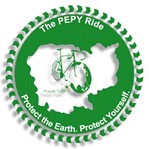 During my visit to Battambang in January, I literally bumped into the half dozen cyclists who were on the first-ever Pepy Ride in Cambodia. They were resting - well, they were actually trying their hand at a cooking class at the Smokin' Pot restaurant - after many days on the road as part of their five week trip visiting schools and orphanages and spreading the Pepy message, 'Protect the Earth. Protect Yourself.' The cyclists, including Daniela and Greta who came up with the original idea, were raising funds to support the building of the Pepy Ride school at Chanleas Dai, a small village a few kilometres north of Kralanh on the main highway between Siem Reap and the Thai border. Following that first trip, the Pepy Ride folks are planning lots more cycle tours in Cambodia and have just instigated a bike-to-school program. You can read all about their excellent efforts at their website, pepyride.org.
During my visit to Battambang in January, I literally bumped into the half dozen cyclists who were on the first-ever Pepy Ride in Cambodia. They were resting - well, they were actually trying their hand at a cooking class at the Smokin' Pot restaurant - after many days on the road as part of their five week trip visiting schools and orphanages and spreading the Pepy message, 'Protect the Earth. Protect Yourself.' The cyclists, including Daniela and Greta who came up with the original idea, were raising funds to support the building of the Pepy Ride school at Chanleas Dai, a small village a few kilometres north of Kralanh on the main highway between Siem Reap and the Thai border. Following that first trip, the Pepy Ride folks are planning lots more cycle tours in Cambodia and have just instigated a bike-to-school program. You can read all about their excellent efforts at their website, pepyride.org.
After our meeting in Battambang, I had the opportunity to stop by the Pepy Ride school in Chanleas Dai on my way north to Samraong a few days later. Here's a photo of me next to the mural that the cyclists, children and other volunteers painted to record the official opening of the school building.
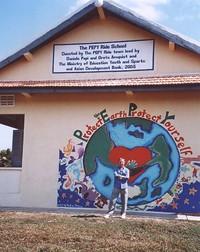
More recommendations for Heang
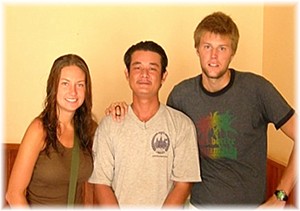 A pal of mine who lives in Siem Reap seems to make a lasting impression on everyone who meets him. Heang was a moto-driver in Sisophon when I first met him in November 2001 and we spent a couple of days tootling around Banteay Chhmar and Sisophon. We've hooked up a couple of times since, including a memorable return visit to Banteay Chhmar, and he now lives in Siem Reap where he makes his living driving tourists around the Angkor temple complex and elsewhere, either in his tuk-tuk or his camry car. The great part about it is that he makes an indelible impression on all who meet him. Take a couple of round-the-world trippers like Daija and Troy. They're currently in Siem Reap and with Heang's encouragement and advice, they're making a difference to the lives of villagers in the hamlet of Phnom Kaowl. The picture above shows Heang in the middle of the two Americans from San Francisco. They're supporting the villagers with food and water pumps and are encouraging their friends and family to help too. Read about their adventures here and see their photographs at their fotki.com website.
A pal of mine who lives in Siem Reap seems to make a lasting impression on everyone who meets him. Heang was a moto-driver in Sisophon when I first met him in November 2001 and we spent a couple of days tootling around Banteay Chhmar and Sisophon. We've hooked up a couple of times since, including a memorable return visit to Banteay Chhmar, and he now lives in Siem Reap where he makes his living driving tourists around the Angkor temple complex and elsewhere, either in his tuk-tuk or his camry car. The great part about it is that he makes an indelible impression on all who meet him. Take a couple of round-the-world trippers like Daija and Troy. They're currently in Siem Reap and with Heang's encouragement and advice, they're making a difference to the lives of villagers in the hamlet of Phnom Kaowl. The picture above shows Heang in the middle of the two Americans from San Francisco. They're supporting the villagers with food and water pumps and are encouraging their friends and family to help too. Read about their adventures here and see their photographs at their fotki.com website.
Heang, as well as appearing on my own website under my recommended guides webpage, has also found support from people like Kim Cooper and more recently Fred Sun, who's set up a website to sing his praises. And rightly so. Heang is someone who helps you to enjoy the sights, sounds and smells of Cambodia and its people because it means as much to him as it does to you.
Cheating Justice
 Fears that Ta Mok, known as 'The Butcher,' wouldn't live to see the tribunal to prosecute the surviving Khmer Rouge leaders, have come to fruition with his death today in a military hospital in Phnom Penh. Having been captured in 1999 and detained for crimes against humanity, the 82 year old had been suffering from respiratory problems and high blood pressure before lapsing into a coma. With his death, another member of the top-ranking Khmer Rouge hierachy has avoided facing trial - Pol Pot, Son Sen and Ke Pauk have already died - leaving just a handful of potential suspects, most of whom still live freely in Cambodia.
Fears that Ta Mok, known as 'The Butcher,' wouldn't live to see the tribunal to prosecute the surviving Khmer Rouge leaders, have come to fruition with his death today in a military hospital in Phnom Penh. Having been captured in 1999 and detained for crimes against humanity, the 82 year old had been suffering from respiratory problems and high blood pressure before lapsing into a coma. With his death, another member of the top-ranking Khmer Rouge hierachy has avoided facing trial - Pol Pot, Son Sen and Ke Pauk have already died - leaving just a handful of potential suspects, most of whom still live freely in Cambodia.
Ta Mok, real name Chhit Choeun, had a reputation as a fierce and brutal leader formed by the purges he implemented on behalf of Pol Pot. After their ousting from power in 1979, he established a guerrilla stronghold in Anlong Veng, as well as logistical bases in Sisaket province in Thailand with the help of the Thai military. For many years he occupied a mansion in the Thai town of Khukan and operated a lucrative trade in smuggling logs from Cambodia. Later he became a partner in at least three Thai petrol stations. In 1997 he split from Pol Pot, whom he put on trial, though he was forced to flee across the Thai border a year later, before the Thai military finally gave up their support for him and he was captured. Ta Mok is known to be directly responsible for many deaths, the most high profile was that of British de-miner Christopher Howes in 1996. Howes worked for the Mines Advisory Group and was kidnapped and executed in Anlong Veng on the orders of Ta Mok by men under his command. Ta Mok's untimely death has cheated the Cambodian people of justice against one of the most feared Khmer Rouge leaders, though he was defiant to the last that he had done no wrong. History will record otherwise.
Wednesday, July 19, 2006
3 Years, 8 Months, 20 Days
 A play entitled 3 Years, 8 Months, 20 Days was first performed in February of this year by members of the Amrita Performing Arts group and was based on the lives of the three female actresses that took part. It was written by Annemarie Prins and the stage designer Fer Smidt has posted the full story at his website, here. Whilst it was very difficult for the three actresses to relive their childhood memories under the Khmer Rouge, actress Chhon Sina felt, "All Cambodians, old and young who went through the Pol Pot regime should stand up together and speak of their harsh life during that brutal regime." A worthy sentiment which she put into practice in the performances of 3 Years, 8 Months, 20 Days. There is also a possibly that the play could be brought to Europe - watch this space.
A play entitled 3 Years, 8 Months, 20 Days was first performed in February of this year by members of the Amrita Performing Arts group and was based on the lives of the three female actresses that took part. It was written by Annemarie Prins and the stage designer Fer Smidt has posted the full story at his website, here. Whilst it was very difficult for the three actresses to relive their childhood memories under the Khmer Rouge, actress Chhon Sina felt, "All Cambodians, old and young who went through the Pol Pot regime should stand up together and speak of their harsh life during that brutal regime." A worthy sentiment which she put into practice in the performances of 3 Years, 8 Months, 20 Days. There is also a possibly that the play could be brought to Europe - watch this space.
The Amrita Performing Arts nonprofit organization was formed in July 2003 as part of the revival and preservation of Cambodian traditional performing arts. Based in Phnom Penh, they have continued to develop their repertoire whilst expanding it to include contemporary expression in dance, theater and music. In 2006 they have tours planned for Spain, Singapore and Austria. Many of the artists involved with Amrita's projects come from the University of Fine Arts - both students and teachers and the three actresses who took part in Annemarie Prins' play, Chhon Sina, Kauv Sotheary and Morm Sokly, are all at the University.
To read more about the activities of Amrita, click on: APA.
[photo courtesy of James Wassermen]
Musical Interlude...
The telephone rang tonight...the call came from a ticketing agency to tell me that the Ennio Morricone concert I was due to attend in London tomorrow night, had been cancelled due to unforseen technical difficulties. Bugger...I'd been looking forward to the concert for months. Morricone's visits to this country are extremely rare and as he gets older, will get even rarer. Thankfully the concert, at the Hammersmith Apollo, and which had been a complete sell-out, has been rescheduled for 1 December, so tickets will remain valid. Fingers crossed for later in the year...
I got home past 4am this morning after attending a very late-night reggae concert in Birmingham city centre, starring the so-called royal family of reggae, Morgan Heritage. They didn't come on stage until 12.45am and whilst the atmosphere and vibe was good, the band were well-received and they played a good mix of new material from their latest album, Full Circle, as well as some of their older tunes, I wasn't overly impressed. The band is anchored by 5 of the 29 children sired by reggae veteran Denroy Morgan, though the female member, Una, was absent, looking after her three small children. I'd seen the band before at the Reggae Sundance festival in Holland in August 2003 and as a concert, their Birmingham appearance was - okay.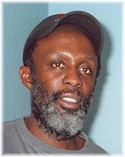
In the audience, I was surprised to see Selwyn Brown and his wife Millie. Selwyn (pictured) told me he'd just returned that day from an eight-date tour of Europe with Steel Pulse, which had followed hard on the heels of a 32-date tour of the United States. After a few days of R&R, he'll be back off to the States for another eight gigs, festivals in Jamaica and Canada before a brief return to Europe for another half dozen festival appearances. Selwyn, and Steel Pulse, just never seem to stop. Also enjoying the concert vibe was Reggae Princess Yaz Alexander.
Monday, July 17, 2006
Battambang's 2 Museums
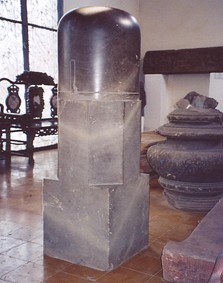 If anyone finds themselves heading towards Battambang, Cambodia's sleepy second city, then I recommend you visit the city's 2 museums, the Provincial Museum on the banks of the Sangker River and the less-accessible Wat Po Veal Museum in the grounds of the pagoda of the same name. I visited both in January 2006 and they certainly have exhibits that are worth checking out. The main Provincial Museum has the best items as you might expect and is now open daily, whilst at Wat Po Veal you need to find the monk, Roeury Rien, who is the keyholder. If he's not about, you probably won't get in. Inside you'll find a series of lintels, some of them upside down, and other carvings amongst the dust and cobwebs - the highlight for me being a sandstone stele with a Sanskrit inscription and carvings in high relief of Brahma, Vishnu and Shiva.
If anyone finds themselves heading towards Battambang, Cambodia's sleepy second city, then I recommend you visit the city's 2 museums, the Provincial Museum on the banks of the Sangker River and the less-accessible Wat Po Veal Museum in the grounds of the pagoda of the same name. I visited both in January 2006 and they certainly have exhibits that are worth checking out. The main Provincial Museum has the best items as you might expect and is now open daily, whilst at Wat Po Veal you need to find the monk, Roeury Rien, who is the keyholder. If he's not about, you probably won't get in. Inside you'll find a series of lintels, some of them upside down, and other carvings amongst the dust and cobwebs - the highlight for me being a sandstone stele with a Sanskrit inscription and carvings in high relief of Brahma, Vishnu and Shiva.
At the main Museum, I was given a guided tour by the Province's director of culture and fine arts, Tub Tan Leang, who described each item in the collection with great pride adding anecdotes about where and when it was found. Most of the lintels on show were removed from the temples surrounding the city and brought to the museum for safekeeping, including a number of items from Banteay Chhmar. Other objects have found their way via a different route, with one large head having been dug up from the museum's garden only a few days earlier! Some of the items on show compare favourably with those at the National Museum in Phnom Penh, including this excellent example of a sandstone linga. In Cambodia, the Hindu god Shiva was represented in the form of an erect phallus and are mostly found in a uniform style; the square base representing Brahma, the octagonal middle section is Vishnu and the cylindrical upper part with a rounded, polished tip, Shiva. The linga would be inserted into a square pedestal, one side of which would have a hollow channel, symbolising a yoni, the vulva-shaped female emblem of power.
I have just posted twenty-six photos taken at the two museums, which you can find here. Next time you are in Battambang, check out its' museums.
Sunday, July 16, 2006
Tiara Delgado's The Road to Closure
 Documentary film-maker Tiara Delgado is a woman on a mission. Born in Oregon, she moved to Los Angeles to take up acting and modeling but instead switched her focus onto humanitarian work and film-making and is currently producing her fourth documentary on Cambodia and its many issues. She's recently finished The Road to Closure - Understanding the Khmer Rouge Tribunal, and has just completed a series of preview screenings of her thirty-minute documentary in the US, at the same time as the trial of the former Khmer Rouge leaders begins to take shape. In 2002 she also set up Global Vision Video which provides production services to educators, activists and non-profit groups seeking to promote their causes on film and video.
Documentary film-maker Tiara Delgado is a woman on a mission. Born in Oregon, she moved to Los Angeles to take up acting and modeling but instead switched her focus onto humanitarian work and film-making and is currently producing her fourth documentary on Cambodia and its many issues. She's recently finished The Road to Closure - Understanding the Khmer Rouge Tribunal, and has just completed a series of preview screenings of her thirty-minute documentary in the US, at the same time as the trial of the former Khmer Rouge leaders begins to take shape. In 2002 she also set up Global Vision Video which provides production services to educators, activists and non-profit groups seeking to promote their causes on film and video.
Delgado (pictured) used her own money to finance her first documentary called Fragile Hopes from the Killing Fields, which she completed in 2003 and which explored the stories behind four survivors and their families, and was narrated by actress Susan Sarandon. Compassion and Controversy was a film about the issues surrounding the adoption of Cambodian orphans, whilst The Road to Closure brings into focus the desire for justice some thirty years after the nightmare in Cambodia began. Still in production is Bitter Mekong - The Sambath Legacy, in which Rami Sambath traces the story of his father who was executed at Tuol Sleng.
To find out more about Tiara Delgado's important work, go to Global Vision.
Saturday, July 15, 2006
The Voices of Survivors
 I know its six months away but looking forward to January 2007, there's a Conference scheduled to take place in Phnom Penh, by which time the tribunal for leading figures in the Khmer Rouge will have taken on more substance and shape. The Conference, to be held under the auspices of Henri Locard of the Royal University of Phnom Penh and the Centre for Social Development, will be called 'The Voices of Survivors and Analysts of Democratic Kampuchea.' Its earmarked for January 18-20, 2007 and should attract a lot of national and international attention.
I know its six months away but looking forward to January 2007, there's a Conference scheduled to take place in Phnom Penh, by which time the tribunal for leading figures in the Khmer Rouge will have taken on more substance and shape. The Conference, to be held under the auspices of Henri Locard of the Royal University of Phnom Penh and the Centre for Social Development, will be called 'The Voices of Survivors and Analysts of Democratic Kampuchea.' Its earmarked for January 18-20, 2007 and should attract a lot of national and international attention.
The list of invited speakers includes such distinquished authors as Loung Ung (First They Killed My Father, Lucky Child), Chanrithy Him (When Broken Glass Floats), Theary Seng (Daughter of the Killing Fields; pictured), Ly Y (Heaven Becomes Hell), as well as award-winning film director Rithy Panh (Site 2, Bophana, Rice People, Land of Wandering Souls, S-21) and animator and cartoonist Bun Heang Ung (Murderous Revolution). The Conference may well coincide with my next visit to Cambodia - if it does I'll move mountains to attend.
Dr Lao Mong Hay - political analyst
 One of Cambodia's loudest voices for democracy and human rights comes from the diminutive figure of Dr Lao Mong Hay, a man not afraid to speak his mind. Oft-quoted in the international press on a wide range of issues, Dr Lao has openly criticised the current political leadership on many occasions, since he returned to live in Cambodia after the 1991 Paris Peace Accords. In fact, he was a leading figure in the peace process, as the head of delegation of the Son Sann-led KPNLF, one of the signatories to the peace agreements, having lived and worked at the Site 2 refugee camp on the Thai border from 1988 to 1992.
One of Cambodia's loudest voices for democracy and human rights comes from the diminutive figure of Dr Lao Mong Hay, a man not afraid to speak his mind. Oft-quoted in the international press on a wide range of issues, Dr Lao has openly criticised the current political leadership on many occasions, since he returned to live in Cambodia after the 1991 Paris Peace Accords. In fact, he was a leading figure in the peace process, as the head of delegation of the Son Sann-led KPNLF, one of the signatories to the peace agreements, having lived and worked at the Site 2 refugee camp on the Thai border from 1988 to 1992.
Currently serving an internship with the Asian Human Rights Commission in Hong Kong, Dr Lao (pictured) was studying for his doctorate in economics at the University of Wales when the Khmer Rouge took over Cambodia in the mid-70s and remained in Britain for the next decade. Following his return to Cambodia, he was Director of the Cambodia Mine Action Centre until the end of 1994 before founding and leading the Khmer Institute of Democracy, an independent think-tank, for the next seven years. For two years from 1995, Dr Lao was the host of a current affairs programme on state-run television called Problems & Solutions. More recently, he's acted as the Head of the Legal Unit for the NGO, Center for Social Development, played a part in regional and international missions and conferences and was awarded the UNHCR Nansen Medal in 2000 for his work with refugees. He continues to speak his mind on issues ranging from the monarchy to the trafficking of women and children and of course, his country's political twists and turns.
Friday, July 14, 2006
After They Killed Our Father
 Hot off the press...quite literally...is the news that Mainstream Publishing have acquired the UK and European rights to After They Killed Our Father by author Loung Ung. The book has already been published in the US by HarperCollins under the title Lucky Child.
Hot off the press...quite literally...is the news that Mainstream Publishing have acquired the UK and European rights to After They Killed Our Father by author Loung Ung. The book has already been published in the US by HarperCollins under the title Lucky Child. Mainstream's Marketing Director Fiona Brownlee is absolutely thrilled with the capture and says; "Loung is extraordinary, young, gorgeous, articulate and incredibly resilient. Her original memoir, First They Killed My Father, in which she described how her parents and most of her family died under Pol Pot's genocidal regime, was an international bestseller and in this new book she describes her own experiences as a refugee who escaped to the West and those of her sister who stayed behind. It is a book which is relevant to everyone. Angelina Jolie recently chose it as her favourite book in a British magazine and said, 'I encourage everyone to read this deeply moving and very important book. Equal to the strength of the book, is the woman who wrote it.'" Mainstream will publish the book in March 2007 and it's hoped Loung will return to Britain for a book tour at that time. Her only previous visit to these shores was in April 2001.
Mainstream's Marketing Director Fiona Brownlee is absolutely thrilled with the capture and says; "Loung is extraordinary, young, gorgeous, articulate and incredibly resilient. Her original memoir, First They Killed My Father, in which she described how her parents and most of her family died under Pol Pot's genocidal regime, was an international bestseller and in this new book she describes her own experiences as a refugee who escaped to the West and those of her sister who stayed behind. It is a book which is relevant to everyone. Angelina Jolie recently chose it as her favourite book in a British magazine and said, 'I encourage everyone to read this deeply moving and very important book. Equal to the strength of the book, is the woman who wrote it.'" Mainstream will publish the book in March 2007 and it's hoped Loung will return to Britain for a book tour at that time. Her only previous visit to these shores was in April 2001.
Thursday, July 13, 2006
Rieng - recommended Angkor guide
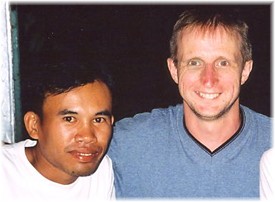 I first hooked-up with Rieng as my guide for the temples of Angkor in December 2000. I owe Christine Dimmock, a pal from Australia who recommended him to me, a debt of gratitude as since that first meet, we've become best buddies and enjoyed a variety of temple-hunting adventures around Siem Reap province. He certainly knows his stuff whether its the main temples in the majestic Angkor complex or more remote and less-visited sites such as the temple ruins on top of Phnom Kulen and other locations well away from the usual tourist routes. We've had some great trips out into the countryside and with Cambodia's seemingly inexhaustible supply of ancient temple sites, I'm looking forward to many more in his company.
I first hooked-up with Rieng as my guide for the temples of Angkor in December 2000. I owe Christine Dimmock, a pal from Australia who recommended him to me, a debt of gratitude as since that first meet, we've become best buddies and enjoyed a variety of temple-hunting adventures around Siem Reap province. He certainly knows his stuff whether its the main temples in the majestic Angkor complex or more remote and less-visited sites such as the temple ruins on top of Phnom Kulen and other locations well away from the usual tourist routes. We've had some great trips out into the countryside and with Cambodia's seemingly inexhaustible supply of ancient temple sites, I'm looking forward to many more in his company.
Now thirty years old, Rieng is a qualified Angkor guide, moto-driver, full-time policeman and father of two. His employers, and wife (Sovann), are very understanding when he has tourists to guide - he's very resourceful, enthusiastic and trustworthy, has a really infectious laugh and a permanent smile, coupled with an excellent grasp of English. He can ferry you around on his moto or can be your guide and arrange for an air-conditioned car or 4WD to make your visit to Angkor more comfortable. His father-in-law, Heng usually takes the wheel and is an expert driver. In the last few years I've got to know Rieng and his family very well and one of the reasons I return to Cambodia each year is to renew friendships, such as the one I have with Rieng. I recommend Rieng as a guide without any hesitation.
You can contact Rieng via e-mail at: kimrieng@yahoo.com or telephone him on: (855) 012 920 554. In the photo above, Rieng is on the left and I'm on the right.
Kudos for website
![]() I went into a bookstore at the weekend for the first time in months and found a book I've literally been waiting years to buy. Its called Culture Shock! Cambodia : A Survival Guide to Customs and Etiquette, written by Peter North. Its been rumoured to be on the verge of publication for the last five years that I know of, and finally, its out, courtesy of Marshall Cavendish. Was it worth the wait...on my initial look, not really, well, not for me. Having been to Cambodia so many times, I have yet to read anything in the book that I wasn't already aware of. However I'm only on page ninety of 270 pages, so it may get better.
I went into a bookstore at the weekend for the first time in months and found a book I've literally been waiting years to buy. Its called Culture Shock! Cambodia : A Survival Guide to Customs and Etiquette, written by Peter North. Its been rumoured to be on the verge of publication for the last five years that I know of, and finally, its out, courtesy of Marshall Cavendish. Was it worth the wait...on my initial look, not really, well, not for me. Having been to Cambodia so many times, I have yet to read anything in the book that I wasn't already aware of. However I'm only on page ninety of 270 pages, so it may get better.
Whilst I was browsing I had a look in a couple of traveller guides to Southeast Asia and more specifically the Cambodia section of these guides. What I found brought a smile to my lips, as both books, published this year.
Rough Guide First-Time Asia:
Famously good and regularly updated collection of travelogues, features and news about Cambodia, plus an active travellers forum.
Southeast Asia On A Shoestring - Lonely Planet:
A great gateway to all things Cambodian, it includes comprehensive links to other sites and regular Cambodan travel articles.
You can read other guidebook referrals and visitor comments, here. I'm often inspired by emails I receive and when they come from a well-respected author and scholar like Dawn Rooney, they mean a lot to me. She wrote; "I looked at your site and it is absolutely amazing. I'm astonished at how much material you have on it. What a tremendous effort. You are making such a major contribution to disseminating information on travel in Cambodia and the art and architecture." More recently, bookshop owner Janet Brown wrote, "I read your essays in To Asia With Love and was consumed with interest and envy, in equal parts. Your adventures are exactly what I yearned for, when I was living in Bangkok... I could definitely sell your Cambodian essays (I spent a large portion of yesterday reading your website).... Your information and insight and damned good writing is what's missing when I turn to books on Cambodia... Once again, so many thanks for the information and generosity of your essays."
All of which reminds me...I've still got to write-up my travel tales from my Cambodia 2006 visit in January. Where's that pen?
Wednesday, July 12, 2006
The multi-talented Ang Choulean
 On the eve of a 5-day international conference to be held at the University of Sydney in Australia under the title, Angkor - Landscape, City & Temple, one of the keynote speakers is a man intimately linked with Cambodia's heritage and cultural identity for many years, Ang Choulean. The line-up of speakers reads like a who's who of Cambodian heritage and includes David Chandler, Milton Osborne, Michael Vickery, Claude Jacques, Son Soubert and Roland Fletcher. Ang Choulean, as a former Director General of APSARA - the authority responsible for the research, protection and conservation of Angkor - an author and noted expert on Khmer folk beliefs, takes a deserved place amongst such esteemed scholars.
On the eve of a 5-day international conference to be held at the University of Sydney in Australia under the title, Angkor - Landscape, City & Temple, one of the keynote speakers is a man intimately linked with Cambodia's heritage and cultural identity for many years, Ang Choulean. The line-up of speakers reads like a who's who of Cambodian heritage and includes David Chandler, Milton Osborne, Michael Vickery, Claude Jacques, Son Soubert and Roland Fletcher. Ang Choulean, as a former Director General of APSARA - the authority responsible for the research, protection and conservation of Angkor - an author and noted expert on Khmer folk beliefs, takes a deserved place amongst such esteemed scholars.
Now 56 years old, Ang Choulean (pictured) was born in Kompong Khleang, one of seven children. After studying archaeology in Phnom Penh, he spent the Khmer Rouge years in Paris, completing his doctorate in anthropology in 1982. He became a professor of historical anthropology at the Royal University of Fine Arts in Phnom Penh in 1990 and has lectured on the ancient Khmer civilization ever since, specialising in religious enthnology. A research associate of the EFEO, he later took over as Director General of Culture and the Angkor Monuments, was the commissioner of the exhibition of Khmer art that toured Paris, Washington, Tokyo and Osaka in 1998 and has published books and journals on his work, including co-editing UDAYA, an annual journal of Khmer studies.
John Dewhirst - Tuol Sleng victim
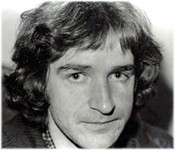 John Dewhirst was the only known British victim at the Khmer Rouge's interrogation centre at Tuol Sleng in Phnom Penh. He was captured off the coast of Cambodia in August 1978, tortured and then executed just a few months before the Khmer Rouge regime was toppled by invading Vietnamese forces in January 1979. His typed confession, like so many of the 14,000 prisoners at S-21, condemned him as a CIA spy. He was one of 200 foreign victims of the Tuol Sleng killing machine, overseen by Comrade Duch, one of just two Khmer Rouge leaders currently in detention, and ready to stand trial for war crimes, sometime in 2007.
John Dewhirst was the only known British victim at the Khmer Rouge's interrogation centre at Tuol Sleng in Phnom Penh. He was captured off the coast of Cambodia in August 1978, tortured and then executed just a few months before the Khmer Rouge regime was toppled by invading Vietnamese forces in January 1979. His typed confession, like so many of the 14,000 prisoners at S-21, condemned him as a CIA spy. He was one of 200 foreign victims of the Tuol Sleng killing machine, overseen by Comrade Duch, one of just two Khmer Rouge leaders currently in detention, and ready to stand trial for war crimes, sometime in 2007.
The story of John Dewhirst can be read here.
Sunday, July 09, 2006
Reggae Princess
 Birmingham's very own 'Reggae Princess', none other than the gorgeous Yaz Alexander, has just launched her own website with video clips, music samples, a biography (with much of the text written by yours truly) and contact details. There's also the opportunity to add much more as Yaz's profile increases. The web address is: yazalexander.com.
Birmingham's very own 'Reggae Princess', none other than the gorgeous Yaz Alexander, has just launched her own website with video clips, music samples, a biography (with much of the text written by yours truly) and contact details. There's also the opportunity to add much more as Yaz's profile increases. The web address is: yazalexander.com.
Much of Yaz's singing career to-date has been in support of reggae industry giants such as Pato Banton and Steel Pulse as a backing vocalist, both live and in the studio, but now the time is right for Yaz to strike out on her own. She has a beautiful voice, a dynamic stage persona and a passion for her music that knows no bounds. Now she needs the opportunity to present that package of personality, talent, ambition and energy to a much wider audience.
Yaz appeared at the Bob Marley One Love festival in Manchester last week in support of reggae artist Kwabena and will also be involved when Morgan Heritage take the stage in Birmingham on the 17th of this month. Yesterday, she appeared with her two backing singers, Emma B and Annie M, at The Stage in Birmingham city centre to showcase her excellent self-penned 'At Christmas' track which she has included on a compilation CD release by Gotham-Records called Christmas in July.
Saturday, July 08, 2006
Angkor Wat re-visited
 Ace cartoonist and animator Bun Heang Ung portrays my latest visit to Angkor Wat! I'm honoured to be one of his subjects. To read my latest blog report on Bun Heang Ung and his work, go to: 02 June 06 - ace cartoonist.
Ace cartoonist and animator Bun Heang Ung portrays my latest visit to Angkor Wat! I'm honoured to be one of his subjects. To read my latest blog report on Bun Heang Ung and his work, go to: 02 June 06 - ace cartoonist.
Bun also sent me an animated banner to use for my website. I think its great. Go here to see the full effect.

Vittorio Roveda - a man of myths & legends
 I met author and renowned Angkor scholar Vittorio Roveda (on the right in the photo above; I'm on the left) in Siem Reap in January, and he very graciously gave me a copy of his latest publication, Images of the Gods, an encyclopedic tome, surveying the motifs and messages recorded in the Khmer temples across Cambodia, Laos and Thailand. It has over 2,400 colour images and is meticulous in defining the sculptural reliefs of the Hindu and Buddhist myths and legends. It's a precious gift to a self-styled temple-hunter like myself, as it helps me understand in precise detail the visual art I encounter on my expeditions into the Cambodian countryside. Vittorio, already author of important books like Khmer Mythology, Sacred Angkor and Preah Vihear, is currently collaborating with Dawn Rooney on a comprehensive guide to the temples of Cambodia, that'll cover both Angkor and beyond, a book that all temple-nuts like me have been waiting a long time for.
I met author and renowned Angkor scholar Vittorio Roveda (on the right in the photo above; I'm on the left) in Siem Reap in January, and he very graciously gave me a copy of his latest publication, Images of the Gods, an encyclopedic tome, surveying the motifs and messages recorded in the Khmer temples across Cambodia, Laos and Thailand. It has over 2,400 colour images and is meticulous in defining the sculptural reliefs of the Hindu and Buddhist myths and legends. It's a precious gift to a self-styled temple-hunter like myself, as it helps me understand in precise detail the visual art I encounter on my expeditions into the Cambodian countryside. Vittorio, already author of important books like Khmer Mythology, Sacred Angkor and Preah Vihear, is currently collaborating with Dawn Rooney on a comprehensive guide to the temples of Cambodia, that'll cover both Angkor and beyond, a book that all temple-nuts like me have been waiting a long time for.
Vittorio has had a multi-faceted career. He gained his first doctorate in geology before switching interests in the 1980s to studying Asian art history. He obtained his second doctorate on the carved reliefs of Angkor Wat six year ago. A former teacher of Asian art history at the University of Singapore, he spends several months each year in Cambodia and also lives in London. To obtain a copy of his incredible new book, Images of the Gods, click on:
Amazon.com.
Friday, July 07, 2006
Justice denied
 A couple of days ago I posted a photo of Pol Pot's birthplace. It seems only right that I should now post a photo of his cremation site, where in April 1998 millions of Cambodian's were denied any real opportunity to seek justice for the crimes committed in his name by his regime, when he died following heart failure. Just under a year earlier, he'd been arrested and underwent a show trial by his own followers and was placed under house arrest. Three days after he died, and following visits by journalists to verify his death, his body was cremated on a pile of rubbish and car tyres.
A couple of days ago I posted a photo of Pol Pot's birthplace. It seems only right that I should now post a photo of his cremation site, where in April 1998 millions of Cambodian's were denied any real opportunity to seek justice for the crimes committed in his name by his regime, when he died following heart failure. Just under a year earlier, he'd been arrested and underwent a show trial by his own followers and was placed under house arrest. Three days after he died, and following visits by journalists to verify his death, his body was cremated on a pile of rubbish and car tyres. I visited the site, on top of the mountain near Anlong Veng and close to the border with Thailand, in December 2003. After his death, on 15 April 1998, the small shack he was living in was dismantled and all that is visible today is a broken toilet bowl amongst the weeds, and his grave, covered with a rusty corrugated tin roof. The site is on a tourist trail around the former headquarters of the Khmer Rouge hierachy, which also includes Pol Pot's bunker and Ta Mok's home. This photo of Pol Pot was taken at his show trial in July 1997.
I visited the site, on top of the mountain near Anlong Veng and close to the border with Thailand, in December 2003. After his death, on 15 April 1998, the small shack he was living in was dismantled and all that is visible today is a broken toilet bowl amongst the weeds, and his grave, covered with a rusty corrugated tin roof. The site is on a tourist trail around the former headquarters of the Khmer Rouge hierachy, which also includes Pol Pot's bunker and Ta Mok's home. This photo of Pol Pot was taken at his show trial in July 1997.
Thursday, July 06, 2006
Pol Pot's birthplace
 This house belongs to Saloth Nhep, the younger brother of Pol Pot. It stands on the same spot, just three miles from the provincial capital of Kompong Thom, as the house in which Nhep and his older brother, Saloth Sar, known to the world as Pol Pot, were both born. The original house, built in a similar style, was destroyed in a bombing raid during the civil war. The house is set back about thirty yards from the River Sen, separated by a cart-track, in a village called Prek Sbauv. It could be any house in any village, anywhere in Cambodia.
This house belongs to Saloth Nhep, the younger brother of Pol Pot. It stands on the same spot, just three miles from the provincial capital of Kompong Thom, as the house in which Nhep and his older brother, Saloth Sar, known to the world as Pol Pot, were both born. The original house, built in a similar style, was destroyed in a bombing raid during the civil war. The house is set back about thirty yards from the River Sen, separated by a cart-track, in a village called Prek Sbauv. It could be any house in any village, anywhere in Cambodia. I visited the village in March 2002. My pal Sokhom, who lives in Kompong Thom, mentioned that Pol Pot was born nearby and asked if I wanted to visit his home. When we arrived in the village, the children in the photo made a fuss of us, as Nhep's wife told us that he was having a siesta but she'd wake him if we wished to meet him. I declined, he was asleep and I wasn't prepared, so I took a couple of photos and played some games with the kids before returning to town. Because of the notoriety of his brother, Nhep, now 80 years old and pictured right, has been interviewed many times by the world's media and explains that though he was very close to his brother in their early years, they lost touch and he was was as surprised, and dismayed, as anyone to find out, in the late '70s, that his brother was the leader of the murderous Khmer Rouge regime.
I visited the village in March 2002. My pal Sokhom, who lives in Kompong Thom, mentioned that Pol Pot was born nearby and asked if I wanted to visit his home. When we arrived in the village, the children in the photo made a fuss of us, as Nhep's wife told us that he was having a siesta but she'd wake him if we wished to meet him. I declined, he was asleep and I wasn't prepared, so I took a couple of photos and played some games with the kids before returning to town. Because of the notoriety of his brother, Nhep, now 80 years old and pictured right, has been interviewed many times by the world's media and explains that though he was very close to his brother in their early years, they lost touch and he was was as surprised, and dismayed, as anyone to find out, in the late '70s, that his brother was the leader of the murderous Khmer Rouge regime.
Wednesday, July 05, 2006
Casualty in Cambodia - update
 Make a note in your diaries... the 2 episodes of Casualty filmed in Cambodia last month will launch the next series of the popular BBC tv drama over one week-end of 23 & 24 September. The filming went extremely well and the episodes will be part of the celebrations for the drama's 20th anniversary.
Make a note in your diaries... the 2 episodes of Casualty filmed in Cambodia last month will launch the next series of the popular BBC tv drama over one week-end of 23 & 24 September. The filming went extremely well and the episodes will be part of the celebrations for the drama's 20th anniversary.
Cathy Shipton (pictured), who plays Duffy in the series, has now recovered from a nasty bug she brought back with her and has told me how well the trip went for her and the crew - "fantastic and a life-enhancing experience" was how she described it. As so many visitors to Cambodia find, it can really grab hold of you and that applies to one member of the crew, who's already returned there for a holiday. Cathy herself, took time out from filming to visit the Sunrise Children's Village orphanage in Phnom Penh as well as one of the schools near Siem Reap that are supported by the British-based Schools for Children of Cambodia charity.
To read more about the Schools for Children of Cambodia, go to: sccambodia.org.
Tuesday, July 04, 2006
The Angry Skies - A Cambodian Journey
Blake Kerr is a medical doctor and author who spent 13 years conducting human rights investigations in Tibet and China before shifting his focus to the atrocities in Cambodia. Having made five visits to Cambodia, he returned for a sixth time with a filmmaker friend, Casey Earl - a pseudonym - to capture on camera some of the many stories he had heard. The resultant documentary - The Angry Skies: A Cambodian Journey - is a film based on interviews with several of the highest-ranking Khmer Rouge heirachy including Nuon Chea, Tep Khunnal and Chouk Rin, as well as survivors like Chum Mey.
It premiered in 2004 and later won the award for the best political documentary at the New York International Independent Film. The full two-hour version of the film is shown at festivals across the United States, whilst Dr Kerr also visits college campuses around the country, showing the film and talking about its consequences. A one-hour version for television has been shown in Israel and Poland and with the forthcoming tribunal, he expects it to be broadcast in the United States this summer. He's also writing a book based on his interviews.
'If the Stones Could Speak' - heritage preservation
Its hoped to encourage a lifelong respect for cultural heritage among Cambodia's next generation. The book stresses the religious importance of ancient sites, especially to Buddhism, which is practiced by 95% of Cambodians. Children's books have been a proven tool in the fight against the illicit wildlife trade, and Heritage Watch hopes this book will be equally successful in protecting cultural heritage. It will be distributed to disadvantaged children throughout Cambodia, but especially to those living in regions of the country where looting is heaviest.
To read more about Heritage Watch and their efforts to protect Cambodia's cultural heritage, as well as Touch Stone, their June newsletter which contained the story of the magical statues, go to: heritagewatch.org.
Sunday, July 02, 2006
Tuol Sleng survivor Chum Mey
 alive. Chum Mey is one of them. As the trial of the surviving Khmer Rouge leaders looms large, Chum Mey (pictured) could be called to bear witness to his own treatment and that of others at Tuol Sleng. He has already appeared in Rithy Panh's documentary about S-21 and been interviewed many times by the world's media, but the recollections cause him great distress on each occasion. He was one of the lucky survivors, like artist Vann Nath, because his skill as a mechanic was useful in repairing sewing machines and typewriters. A note at the end of his confession, penned by S-21's chief Comrade Duch, read, "Keep for a while." His wife and baby didn't survive, memories that still haunt him. Now 72, he's re-married and has six children and has been a vocal advocate of the forthcoming tribunal.
alive. Chum Mey is one of them. As the trial of the surviving Khmer Rouge leaders looms large, Chum Mey (pictured) could be called to bear witness to his own treatment and that of others at Tuol Sleng. He has already appeared in Rithy Panh's documentary about S-21 and been interviewed many times by the world's media, but the recollections cause him great distress on each occasion. He was one of the lucky survivors, like artist Vann Nath, because his skill as a mechanic was useful in repairing sewing machines and typewriters. A note at the end of his confession, penned by S-21's chief Comrade Duch, read, "Keep for a while." His wife and baby didn't survive, memories that still haunt him. Now 72, he's re-married and has six children and has been a vocal advocate of the forthcoming tribunal.Nic Dunlop interviewed Chum Mey at length for his book about Duch, called The Lost Executioner. Chum Mey was also the subject of this article by The Age newspaper in Australia, dated January 2004: Survivor rises to bear witness from the killing fields.
Lucretia Stewart's Lotus Season
Author and travel writer Lucretia Stewart penned the 1992 travel book, Tiger Balm: Travels in Laos, Vietnam & Cambodia, which alongwith Sue Downie's Down Highway One, were the first couple of modern travel books I'd read about Cambodia around the time of my first-ever trip to Cambodia in November 1994. So I was intrigued to find a travel article she wrote in 1997 called Lotus Season, that appeared in an anthology and a radio programme called Amazonians at the time. I was particularly intrigued because it was the story of her friendship with Tan Sotho, the managing director of Phnom Penh-based travel company Hanuman Tourism and mum-in-law to Nick Ray, and mother to his wife, Kulikar Sotho. I'd been friends with Nick - he of Lonely Planet fame - and Kulikar for a while before I met Mrs Sotho way back in December 2000 when she invited me to an evening meal in Siem Reap, so to read Stewart's bio of her was absorbing.
Lord Jim and Peter O'Toole
If you thought Tomb Raider was the first big-budget movie to be made in Cambodia, think again. In 1963 the swashbuckling tale of Lord Jim was filmed in and around Angkor Wat and starred Peter O'Toole, James Mason, Eli Wallach and Daliah Lavi, as the token love interest. In its day, Lord Jim, adapted from the Joseph Conrad novel, cost a massive $10 million to make and filming took place in Hong Kong before the cast and crew moved to Angkor. In an interview for Time Magazine in January 1964, Peter O'Toole, who was hot box-office property after the runaway success of Lawrence of Arabia, was clearly not enamoured with his experiences in Southeast Asia. Here's some extracts from the interview:
Then the company moved on to Cambodia. For all the anti-Western ferment in the Southeast Asia country, producer-director Richard Brooks had managed to get permission to shoot location scenes in jungles and around the ancient temple ruins of Angkor Wat. To accommodate his large cast and crew, Brooks had to spend $600,000 to add a 47-room wing onto a little hotel near the location. "That hotel!" rages O'Toole. "More expensive than Claridge's! Ten flaming quid a night [$28] and a poxy room at that. Nicest thing you could say about the food was that it was grotesque." Soon everyone was set upon by dysentery, giant stinging insects and prickly heat rash that made clothing unbearable. Then came the snakes, which seemed to have a particular curiosity about show business. Walking down the middle of a jungle road, O'Toole came face to face with a huge black cobra. "They say no snake can travel faster than a scared human," he recalls, "but I ain't so sure. The snake went like hell, but luckily away from me." Another cobra slithered onto the set and dropped to the floor of the makeshift ladies' rest room. As screeching pandemonium broke out, a grip rushed to the rescue, killing the snake and stretching it out to its awesome seven-foot length. Then, an almost identical cobra appeared, eluded its chasers and presumably lurked in the shadows through the night's jittery shooting. One feminine member of the crew discovered two snakes curled up inside the commode - but did not linger to figure out what kind they were. Of particular dread was a snake called the 'two-step'. "It bites you, you take two steps," explains O'Toole, "and then you die. One day there was a nasty cop around and he had one curled around his foot. Flaming lovely discretion shown by the snake. It didn't bite the guy, so justice isn't total."
Peter O'Toole and Daliah Lavi in 1964
Almost as annoying as the snakes were the Cambodian officials, many of whom seemed to think the movie company had come just for the privilege of paying bribes. One day Crown Prince Sihanouk, Cambodia's pro-Peking ruler, showed up. "He started yelling the usual anti-British crud," says O'Toole. "I walked up to him and said, 'I couldn't agree with you more. I'm Irish meself.'" A mysterious Frenchman appeared on the location one day and darkly advised Brooks to get his company out of Cambodia by March 12. Unlike Caesar, who paid no heed to the soothsayer, Brooks for some reason believed the man. With O'Toole's concurrence, the work schedule was doubled and the daily shooting went on from noon until nearly dawn. The scheduled 12 weeks was thus cut to nine and the company left the country on March 3. One week later the US and British embassies were attacked by mobs (O'Toole is convinced that some of the trouble-makers had worked in the film as extras.) Prince Sihanouk took to the national radio to denounce the movie company as 'Western imperialist invaders.' "If I live to be a thousand," says O'Toole, "I want nothing like Cambodia again. It was a bloody nightmare. I really hated it there. How much so you can judge by the fact that after six months in the Orient I hadn't picked up a single word there, whereas after nine months in the desert on Lawrence I was speaking Arabic pretty well."
Saturday, July 01, 2006
Khmer Rouge tribunal a step nearer
 In two days time, 30 Cambodian and international judges will be sworn in and work will start in earnest on preparing the ground for the opening of the long-awaiting trial of the Khmer Rouge hierachy, well those that are still alive, sometime in early 2007. Its taken many years to get to this stage, after delays and prevarication by both the Cambodian government and the United Nations over the format and funding for the tribunal. In the meantime, key suspects have died, including Pol Pot, Son Sen and Ke Pauk, whilst the surviving former KR senior figures are all in their seventies, some with failing health but most are still living freely in Cambodia. I've yet to see a definitive list of those that will be indicted but its sure to include Ta Mok (pictured) and Duch, the only two that are currently in custody, as well as Khieu Samphan, Ieng Sary, Nuon Chea, Khieu Thirith and possibly current serving military officers such as Sou Met and Meas Muth, who defected from the Khmer Rouge.
In two days time, 30 Cambodian and international judges will be sworn in and work will start in earnest on preparing the ground for the opening of the long-awaiting trial of the Khmer Rouge hierachy, well those that are still alive, sometime in early 2007. Its taken many years to get to this stage, after delays and prevarication by both the Cambodian government and the United Nations over the format and funding for the tribunal. In the meantime, key suspects have died, including Pol Pot, Son Sen and Ke Pauk, whilst the surviving former KR senior figures are all in their seventies, some with failing health but most are still living freely in Cambodia. I've yet to see a definitive list of those that will be indicted but its sure to include Ta Mok (pictured) and Duch, the only two that are currently in custody, as well as Khieu Samphan, Ieng Sary, Nuon Chea, Khieu Thirith and possibly current serving military officers such as Sou Met and Meas Muth, who defected from the Khmer Rouge.
Ta Mok has been in detention since March 1999 but his health is failing fast and fears abound that he may not survive long enough to face trial. It was Ta Mok that put Pol Pot on trial in July 1997 after he took control of the remaining Khmer Rouge forces in Anlong Veng. Pol Pot died in April 1998 though Ta Mok was later forced to flee across the Thai border and was captured in 1999. He's now 82, in detention for crimes against humanity and has high blood pressure and respiratory problems. The only other detainee is Duch, the former head of S-21, the KR's chief interrogation and extermination centre. He's the only one who has confessed to his crimes and his evidence will be crucial in connecting the other senior leadership figures to the genocide and mass murder that took place in the '70s.
Roy Hill & Cry No More
 Hats off to eBay, the on-line auction website, where I've just completed my collection of vinyl LP's for the band Cry No More. Their debut album, Smile, released in 1986, had eluded me until now and for less than a fiver a pristine version is now in my LP library. So who are Cry No More you might ask? They were a rocky-pop-fun-cultish duo of Roy Hill and Chas Cronk, who got together in 1985, released three albums and a string of singles before calling it a day in 1994. Their live act was 70% comedy, 30% serious and audience participation was actively encouraged in the colleges, theatres and pubs where they performed. They get together every Christmas for a reunion bash and its a hoot.
Hats off to eBay, the on-line auction website, where I've just completed my collection of vinyl LP's for the band Cry No More. Their debut album, Smile, released in 1986, had eluded me until now and for less than a fiver a pristine version is now in my LP library. So who are Cry No More you might ask? They were a rocky-pop-fun-cultish duo of Roy Hill and Chas Cronk, who got together in 1985, released three albums and a string of singles before calling it a day in 1994. Their live act was 70% comedy, 30% serious and audience participation was actively encouraged in the colleges, theatres and pubs where they performed. They get together every Christmas for a reunion bash and its a hoot.
My first encounter with Roy Hill (pictured) came about in early 1978 when I saw him perform, with his band, at Hammersmith Odeon and I was hooked. Not only was he from my hometown but his music was top drawer and catchy. I immediately thought he was destined for the top. And so did his record label Arista. However, after one album and a handful of singles failed to chart, the label changed its mind and Roy fell from grace until his re-emergence with Cry No More. Today, Roy is still writing songs and is planning to perform live with his new material sometime soon.
